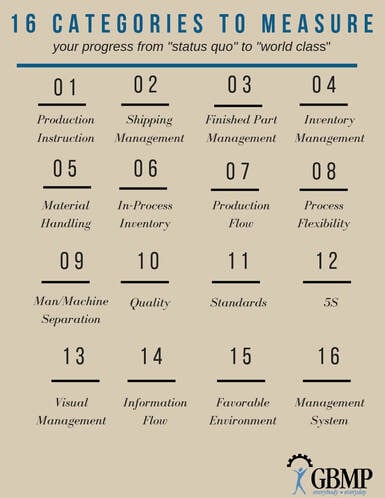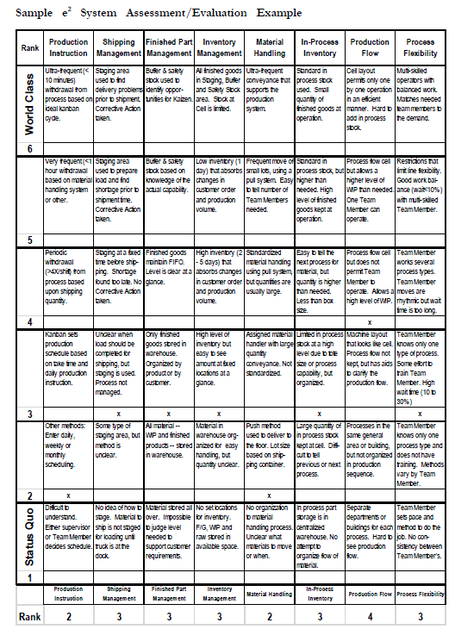
It is management’s role to continuously assess the current condition of the Lean implementation and provide appropriate support and motivation to raise the bar. Failure to keep a watchful eye on True North has caused many a Lean effort to fail. Perhaps management has invested in classroom training, but no time for action (and therefore no
tacit learning.) In other instances, the effort may be treated as a “crash program” which will indeed end with a crash and gradual return to the
status quo aka “business as usual”. In many cases however, companies do achieve early benefits but are challenged to sustain and accelerate their improvements. Assessments can be used on an on-going basis to challenge and re-invigorate your efforts.
There are 16 categories for evaluation
through direct observation. Each describes a key business function as a work in progress, advancing from traditional practice to Lean thinking. Don’t be discouraged if your initial scores are low. That would be normal.
Ultimately every aspect of a business requires reconsideration. The current condition was not built up over night. It represents decades or more of practice and development. Kaizen is the means to re-align resources to TPS philosophy. For employees it represents small changes for the better in their daily work. For management, kaizen is the means to re-think strategy, organization and policy, and to implement incremental changes to the management system.
Here's a brief description of each of the 16 categories:
- Production Instruction – Is our production based on speculation (push) or actual customer requirement (pull)?
- Shipping Management – Are problems found early and fixed immediately?
- Finished Part Management – Is it the outcome of push production or is it a buffer to facilitate Kanban improvement?
- Inventory Management - How many days are maintained? Are locations & quantities clear?
- Material Handling - Are parts moved to the floor infrequently in big batches (push?) or small quantities according to need (pull)?
- In-Process Inventory - Are large quantities of WIP produced too early & moved to a warehouse? Are production quantities determined by capability or container size?
- Production Flow - Is the workplace laid out functionally with long distances b/w ops or has flow distance been reduced to combine ops closer.
- Process Flexibility - Are workers trained to do only one job or able to handle different tasks Is workload balanced?
- Man/Machine Separation - Are workers tied to machines or have improvements been made to allow workers’ time to be divided?
- Quality - Is inspection done remotely in batches or on the spot, one-by-one?
- Standards - Do work standards exist? Are they followed? Are they integrated with kaizen or do they thwart improvement?

12.
5S - Is the workplace cluttered or well-organized? Is 5S considered an on-going process? Are all employees engaged?
13.
Visual Management & Control - Are operating conditions clear at a glance? Does management receive and respond to visual communications? Is it frequent and reflective of changing conditions?
14.
Information Flow - Are problems hidden from management or “made ugly”? Is management on the floor regularly to “go see”?
15.
Favorable Environment - Does the environment encourage employee participation with teams or suggestions? Is there enthusiasm for improvement?
16.
Management System - What is the current condition of policies and measures? Is it “status quo”, and contradictory to True North?
For the full description of each of the 16 categories to measure on your journey from “status quo” to “world class”, get your digital copy of the “
e2 Continuous Improvement System” here. Includes an example Assessment Matrix and suggestions on how to score each category.

